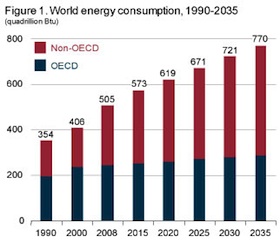EIA: Energy Consumption to Increase 53 Percent by 2035
 WASHINGTON — Worldwide energy consumption is expected to increase by 53 percent between 2008 and 2035, according to the International Energy Outlook 2011 released by the U.S. Energy Information Administration.
WASHINGTON — Worldwide energy consumption is expected to increase by 53 percent between 2008 and 2035, according to the International Energy Outlook 2011 released by the U.S. Energy Information Administration.
The report presents updated projects for world energy markets through 2035 and predicts that much of the increase will be driven by strong economic growth in developing nations, especially China and India.
"China and India account for half of the projected increase in world energy use over the next 25 years,” said Acting EIA Administrator Howard Gruenspecht. “China alone, which only recently became the world’s top energy consumer, is projected to use 68 percent more energy than the United States by 2035."
Key findings of the report state that the economies of China and India were among the least affected by the worldwide recession, and the two countries continue to lead world economic growth and energy demand growth in the Reference case.
“In 2008, China and India combined accounted for 21 percent of total world energy consumption,” the report states. “With strong economic growth in both countries over the projection period, their combined energy use more than doubles by 2035, when they account for 31 percent of world energy use in the IEO2011 Reference case.”
China’s energy demand is expected to be 68 percent higher than U.S. energy demand by 2035, according to the report.
The report also found that while renewable energy is projected to be the fastest-growing source of primary energy over the next 25 years, fossil fuels will remain the dominant source.
While the rate of renewable energy consumption increases about 3 percent per year, and the renewable share of total energy use increases from 10 percent in 2008 to 15 percent in 2035 in the Reference case, fossil fuels will continue to supply much of the energy used worldwide through the projection and will still account for 78 percent of world energy use in 2035.
Among fossil fuels, natural gas has the fastest growth rate over the 2008 to 2035 projection period, with world natural gas consumption rates increasing at 1.6 per year—from 111 trillion cubic feet in 2008 to 169 trillion cubic feet in 2035.
Unconventional natural gases like tight gas, shale gas and coalbed methane supplies increase substantially in the IEO2011 Reference case—especially from the United States, but also from Canada and China, according to the report.
The report also states that world oil prices remain high in the Reference case but oil consumption continues to grow. Both conventional and unconventional liquid supplies are used to meet rising demand.
Authors of the report state that while the Reference case projects reflect current laws and policies as of the start of 2011, “past experience suggests that renewable energy deployment is often significantly affected by policy changes.”
The International Energy Outlook 2011 Reference case projection does not incorporate prospective legislation or policies that might affect energy markets, according to administration officials.
For details on the key findings and additional highlights, the full text of the International Energy Outlook can be found at: http://www.eia.gov/forecasts/ieo/.
